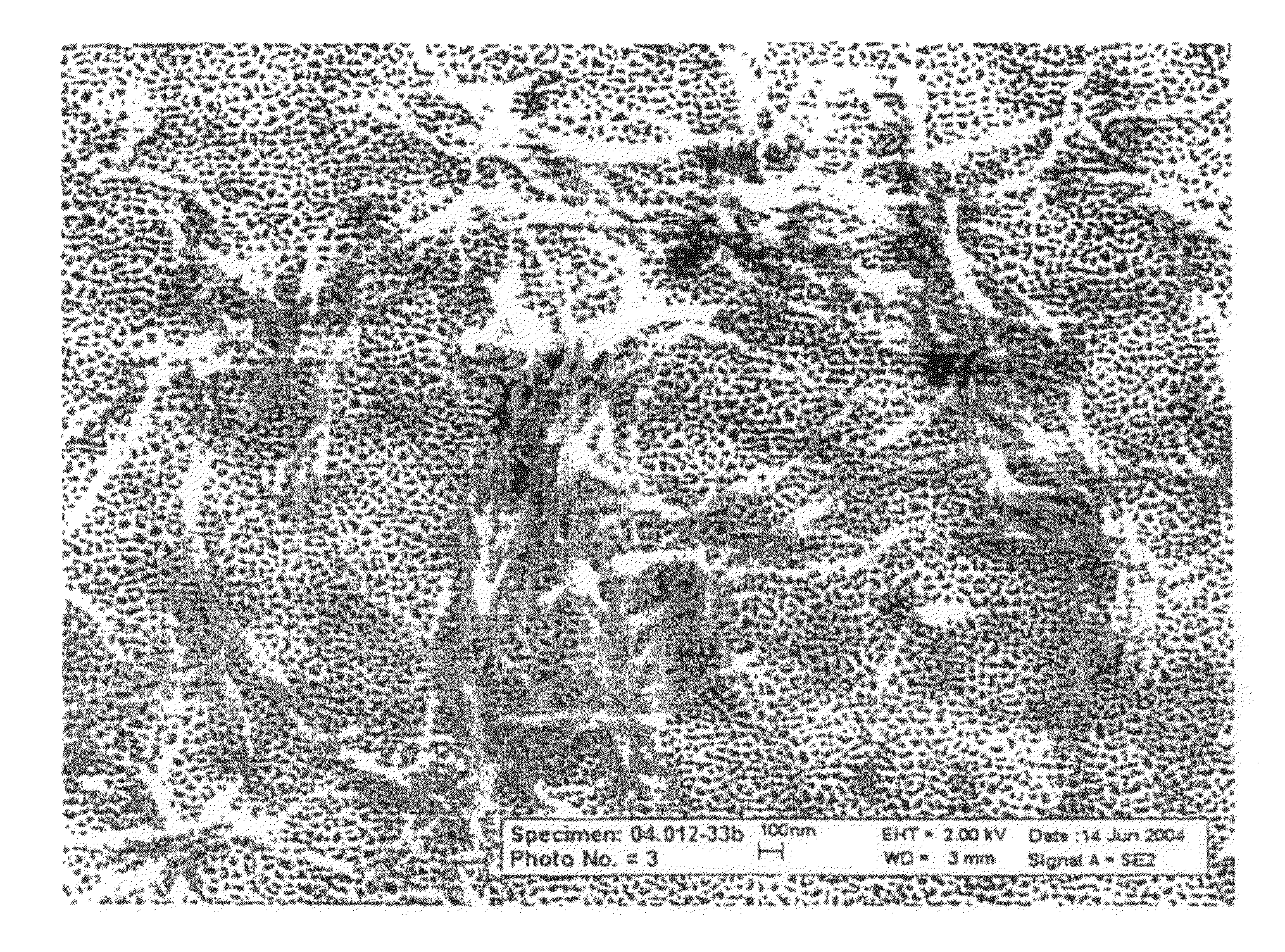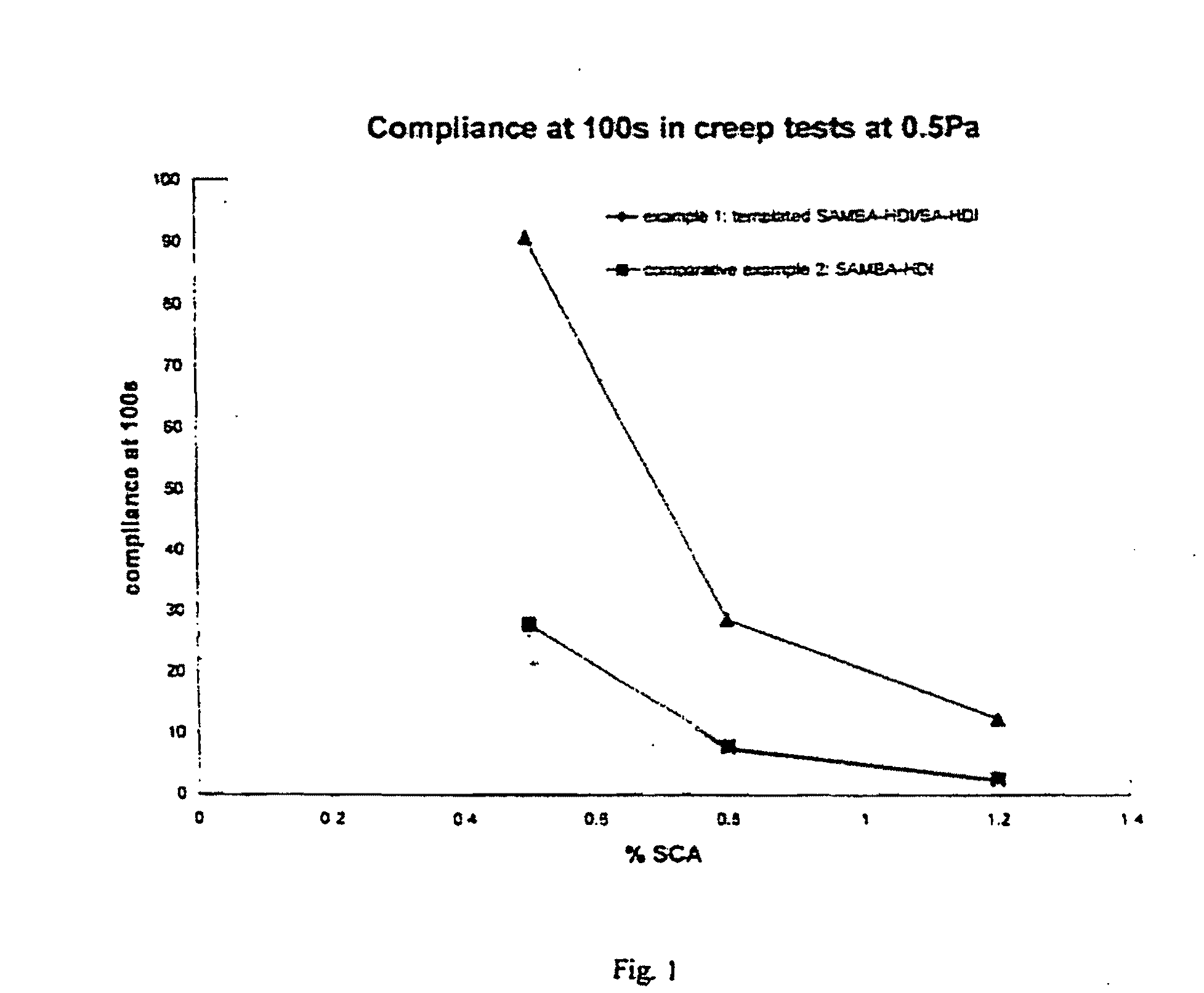Polyurea Product as Thixotropic Rheology Modifying Agent
- Summary
- Abstract
- Description
- Claims
- Application Information
AI Technical Summary
Benefits of technology
Problems solved by technology
Method used
Image
Examples
example 1
(90 / 10) S / R-AMBA+HDI / BA+HDI in Setal 166 SS-80 (1:1)
[0093]100.0 g of Setal 166 SS-80 was added in a reactor, and mixed with 0.06 g (0.5 mmoles) of R-(+)-α-methylbenzylamine and 0.58 g (4.8 mmoles) S-(−)-α-methylbenzylamine, using a rotating disk dissolver at 1500 rpm for 2 minutes. The stirring speed was raised to 4000 rpm, and 0.46 g (2.7 mmoles) of 1,6-hexamethylenediisocyanate was added using a syringe. The mixture was stirred for an additional 30 seconds at 4000 rpm. The stirring speed was reduced to 1000 rpm and after 2 minutes 0.60 g (5.6 mmoles) benzylamine was added. A mixture of 0.49 g (2.91 mmoles) 1,6-hexamethylenediisocyanate and 0.49 g butylacetate was added to the reactor in 15 minutes using a pump. The mixture was stirred for an additional 30 seconds at 1000 rpm.
example 1a
(90 / 10) S / R-AMBA+HDI / BA+HDI in Setal 166 SS-80 (1:1)
[0094]100.0 g of Setal 166 SS-80 was added in a reactor, and mixed with 0.06 g (0.50 mmoles) of R-(+)-α-methylbenzylamine and 0.58 g (4.8 mmoles) S-(−)-α-methylbenzylamine, using a rotating disk dissolver at 1500 rpm for 2 minutes. The stirring speed was raised to 4000 rpm, and 0.46 g (2.7 mmoles) of 1,6-hexamethylenediisocyanate was added using a syringe. The mixture was stirred for an additional 30 seconds at 4000 rpm. The stirring speed was reduced to 1000 rpm and after 5 minutes 0.60 g (5.6 mmoles) benzylamine was added. The mixture was stirred for an additional 2 minutes at 1000 rpm. The stirring speed was raised to 1500 rpm and 0.50 g (2.97 mmoles) 1,6-hexamethylenediisocyanate was added using a syringe. The mixture was stirred for an additional 30 seconds at 1000 rpm.
example 2
(90 / 10) S / R-AMBA+HDI / BA+HDI in Setal 166 SS-80 (1:1)
[0101]100.0 g of Setal 166 SS-80 was added in a reactor, and mixed with 0.06 g (0.5 mmoles) of R-(+)-α-methylbenzylamine and 0.58 g (4.8 mmoles) S-(−)-α-methylbenzylamine, using a rotating disk dissolver at 1500 rpm for 2 minutes. The stirring speed was raised to 4000 rpm, and 0.46 g (2.7 mmoles) of 1,6-hexamethylenediisocyanate was added using a syringe. The mixture was stirred for an additional 30 seconds at 4000 rpm. The stirring speed was reduced to 1000 rpm and after 2 minutes 0.60 g (5.6 mmoles) benzylamine was added. A mixture of 0.49 g (2.9 mmoles) 1,6-hexamethylenediisocyanate and 0.49 g butylacetate was added to the reactor in 15 minutes using a pump. The mixture was stirred for an additional 30 seconds at 1000 rpm.
PUM
| Property | Measurement | Unit |
|---|---|---|
| Fraction | aaaaa | aaaaa |
| Fraction | aaaaa | aaaaa |
| Fraction | aaaaa | aaaaa |
Abstract
Description
Claims
Application Information
 Login to View More
Login to View More - R&D
- Intellectual Property
- Life Sciences
- Materials
- Tech Scout
- Unparalleled Data Quality
- Higher Quality Content
- 60% Fewer Hallucinations
Browse by: Latest US Patents, China's latest patents, Technical Efficacy Thesaurus, Application Domain, Technology Topic, Popular Technical Reports.
© 2025 PatSnap. All rights reserved.Legal|Privacy policy|Modern Slavery Act Transparency Statement|Sitemap|About US| Contact US: help@patsnap.com



